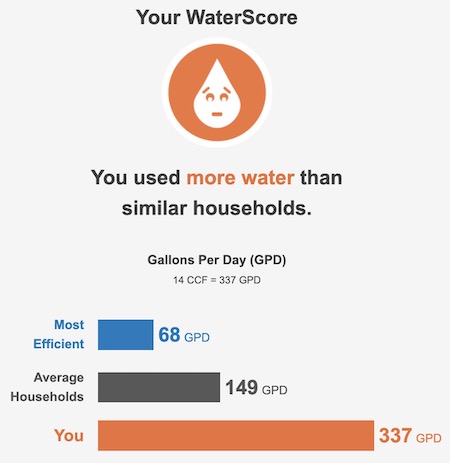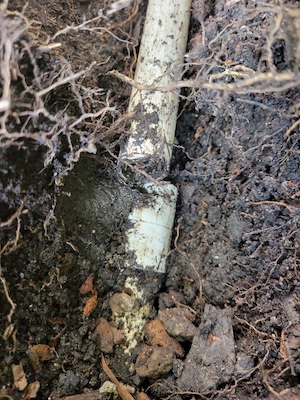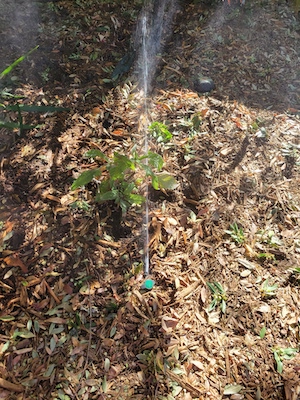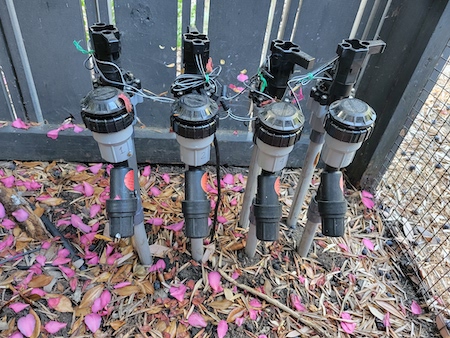I recently got a nag email from the City of Palo Alto telling me that my house uses too much water. Not only am I using far more water than similar households, it is getting worse. “Sheralyn, you're using 49% more water this year than last year.” Don’t I care about the drought? And how is it even possible to use that much water?

I don’t find this monthly nag to be helpful. The house has always used a lot of water and it is proving difficult and expensive to use less. Palo Alto’s high water rates and the state’s tendency to be in drought do mean that I care about water use. But whatever I do will never be enough for the city, short of killing my plants.

Water use at my house has changed over the last years as I have made adjustments, but it has never been low. Invisible leaks during the wet season last year meant even that year was bad.
I have mulched over a lawn, replaced it with low-water natives, replaced spray irrigation with inline drip, and put in smart controllers. Water use has gone up and down, but lately it’s taken another turn up. Part of the problem is leaks.

A shovel broke a PVC irrigation pipe that was not buried deep enough.
The house has a long history of water leaks, from stuck toilet flappers to below-slab leaks. But almost all of the problems have been outside, on a 9200 square foot lot with 13 irrigation zones and all manner of plants. I’ve had leaks from redwood roots breaking irrigation. From Japanese maple roots strangling and holding down a fountain refill. From a settling structure breaking an irrigation pipe. From a shovel breaking an irrigation pipe. From a dog chewing off a sprinkler head. From a leaky irrigation valve.

A drainage valve on an inline drip system got knocked slightly askew, causing it to spray out water when irrigation was running.
I have fixed all of these things. I even moved all the irrigation valves above ground so it’s easier to see leaks. But it’s still not enough. The new smart controller is buggy. (1) The inline drip has drainage valves that can get knocked open. The low-water plants are only low-water once they are established. The inline drip is not so efficient when plants are young and small.

Above-ground irrigation valves are pretty ugly but it’s easier to see and fix leaks.
Some of these leaks can be pretty expensive due to our high water rates. The first big leak I had, many years ago from a growing redwood root breaking a pipe, sent my water bill soaring to $800+. The utility refused to refund any of it. Nowadays they will issue a refund, but only for a permanent fix. When I found the fountain refill was being held down by roots, I turned off the refill, but that wasn’t good enough to get a refund. Since I wasn’t replacing the fountain for a year, which was too late to file, I never did get a refund. In fact, I have never gotten a refund, partly from lack of awareness that at some point they became available, and partly because I dreaded the paperwork. But these leaks add up. The most recent one was about 6 gallons/hour, or about $70 for the month (6 CCF).

Tracking down a leak using a standard water meter is no picnic.
Even if I manage to stay on top of all the leaks, my usage will never be that of “similar” homes. The smart controller, when it’s working, estimates I need from 7-10 CCF during a non-rainy month, just for the yard. That works out to around 200 gallons per day. Alternatively, if you estimate about a half inch of water every two weeks (that is about one-third of a gallon per square foot), then that comes to about 100 gallons per day for 5000 square feet of planted area. A single large tree, of which I have several, can use 400 gallons per week.
So, what is my point? I think I’m just annoyed with the city’s emails. It is my choice (and my good fortune) to have a large plant-filled lot. My monthly bill reminds me of the cost, and also gives me a clue when there might be a leak. So I’m not sure what the nag emails add. The leaks are not going to stop and the water use is never going to be low. 15 gallons of water is enough for a ten-minute shower, a load of laundry, or ten toilet flushes. But that same 15 gallons covers just 1% of my planted area every 1-2 weeks.

I’ve already done everything the city suggests, and more.
Maybe it would help if the city asked, in addition to how many people are in a house, how many planted square feet there are, how many large trees there are, how mature the landscape is. Maybe a Recommended Action should be “Remove plants”.
What would actually help is more proactive notification of leaks. They aren’t hard to detect. The new water meters will help, but I don’t know when I will get one, so I finally caved and bought my own real-time water monitor. That will make it faster and easier to track down the inevitable leaks, especially since it will hook into the smart controller. Hopefully over time, as more of my plants develop robust root systems, I will be able to dial down the water and finally save some money.
Notes and References
1. Do not buy a BHyve smart controller. They are unreliable and the software is terrible.
Current Climate Data
Global impacts (September 2023), US impacts (September 2023), CO2 metric, Climate dashboard
Doesn’t it feel strange to have such warm weather when the days are getting shorter? From Climate Central: “This October, San Jose was much warmer than normal and much drier than normal. The average temperature of 68.2°F was 3.9° above normal, and the 0.11 inches of precipitation was 21% of the normal amount (data are from SC-ACIS and normal is defined relative to the 1991-2020 NCEI climate normal). This year stood out as the third warmest October in San Jose in data going back to 1893.”
Comment Guidelines
I hope that your contributions will be an important part of this blog. To keep the discussion productive, please adhere to these guidelines or your comment may be edited or removed.
- Avoid disrespectful, disparaging, snide, angry, or ad hominem comments.
- Stay fact-based and refer to reputable sources.
- Stay on topic.
- In general, maintain this as a welcoming space for all readers.



